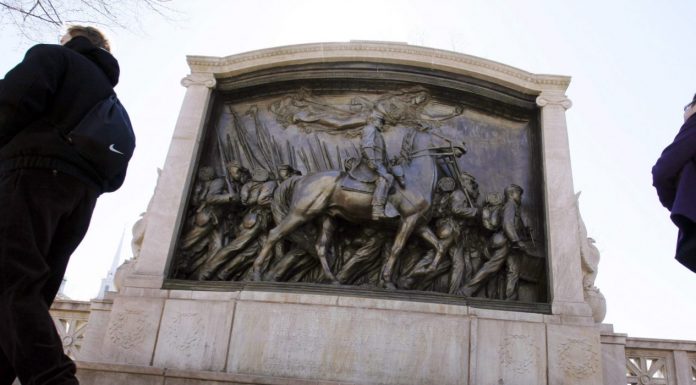(Headline USA) The white Union Army commander sits rigid atop an imposing horse. His black men, rifles to their shoulders, march resolutely alongside on their way to battle.
For L’Merchie Frazier, the towering bronze relief in downtown Boston captures the stirring call to arms answered by black soldiers who served in the state’s famed Civil War fighting unit, which was popularized in the 1989 Oscar-winning movie “Glory.”
But the longtime Boston artist says she understands how the imagery of the Robert Gould Shaw and Massachusetts 54th Regiment Memorial can conjure mixed feelings as the nation takes another hard look at its monuments and memorials in the wake of recent race riots.
“Whose story is being told with this monument?” said Frazier, who is the education director at the nearby Museum of African American History. “The hierarchy is very evident. White commander out front; black soldiers in the background. It’s the first thing you see.”
Amid the national reckoning on racism, the Shaw memorial is the latest and, perhaps, one of the more curious to receive scrutiny.
Unlike other felled monuments, the work by American sculptor Augustus Saint–Gaudens isn’t a paean to the Confederacy.
It doesn’t have explicit ties to colonialism, such as the Christopher Columbus monuments that have been toppled in Boston and elsewhere.
Instead, the creation of the memorial in the aftermath of the Civil War was championed by prominent black Bostonians of the day.
It was originally envisioned as a traditional equestrian monument to Shaw, but the colonel’s family, a wealthy Boston clan strongly opposed to slavery, requested that it also honor the black men who served and died alongside him during their famed charge on Fort Wagner in Charleston, South Carolina, in 1863.
The monument is also significant because it’s the nation’s first honoring black soldiers, said Elizabeth Vizza, executive director of the Friends of the Public Garden, a group helping pay for a $3 million restoration of the monument, which started in earnest in May.
Saint-Gaudens spent 14 years creating a richly detailed bas relief, using black men of different ages as models for his realistic soldiers. After it was unveiled to fanfare in 1897, American author Henry James declared the work “real perfection,” according to the National Park Service.
“This was a radical piece of art,” Vizza said. “It was not lost on people back then.”
The work, which sits across from the Massachusetts Statehouse, has been vandalized over the years, mostly by people snapping off Shaw’s broadsword. But during the unrest that followed Floyd’s killing in May, the monument was tagged with anti-police slogans, expletives and other graffiti, along with about a dozen others in and around the Common.
Kevin Peterson, founder of the New Democracy Coalition that’s calling on Boston to rename Faneuil Hall after Crispus Attucks, said the Shaw monument should be moved to a museum because it casts blacks as “subservient” to whites.
Similar complaints have prompted the removal of other ostensibly well-meaning monuments in recent weeks, including a statue of Theodore Roosevelt in front of the American Museum of Natural History in New York and a statue of Abraham Lincoln depicting a freed slave kneeling at his feet in Boston.
The Rev. Vernon Walker, a board member with Massachusetts Peace Action, which has called for changing the state seal’s controversial depiction of a Native American man, suggests the Shaw memorial could better recognize the achievements of the black soldiers themselves.
Roughly half the regiment’s 600 soldiers were killed, wounded, captured or presumed dead following the failed assault on Fort Wagner, and their heroism inspired tens of thousands of black men and others to sign up for the Union Army, helping turn the tide of the war.
Sgt. William Carney became the first black man awarded the Medal of Honor for saving the regiment’s flag from capture. Two sons of prominent black abolitionist Frederick Douglass, who had pushed Lincoln to allow blacks to serve in the war, also fought at Fort Wagner.
But while the names of Shaw and other fallen white commanding officers were etched in the monument from its unveiling, those of the black soldiers weren’t added until the 1980s, during its last major facelift.
The film “Glory” features shots of the restored monument in its end credits. Director Edward Zwick and leading cast members, including Matthew Broderick, Denzel Washington and Morgan Freeman, declined to comment through their representatives.
For now, the Shaw memorial is not among the public works that have come up as Boston continues to review public concerns about city monuments in the wake of the national debate on racism, said Mark Pasnik, who chairs the city’s Art Commission overseeing the process.
But Vizza, of the park group, doesn’t think the memorial, which is expected to be restored by November, should be changed or moved.
She believes people will have a greater appreciation for the work if they simply learn more about it, something her organization, the mayor’s office, and the National Park Service have taken pains to do.
Ahead of the restoration, which included disassembling parts of the memorial last week, officials hosted forums on public monuments that included prominent black scholars and civil rights activists.
A temporary exhibit also has been installed on the fencing around the construction site detailing the 54th regiment’s exploits. And a new “augmented reality” app leads people on a virtual tour of the monument where they can learn more about its significance and ongoing restoration.
Frazier, of the Museum of African American History, says those are all laudable steps, and agrees the monument should remain where it is.
“It’s not enough to just see the piece. You have to go deeper,” she said. “There’s so much not told, but the monument is so moving that it can lead you to those things, if you’re curious.”
Adapted from reporting by the Associated Press

